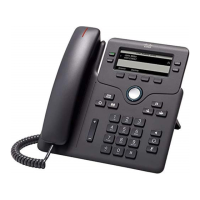Description and More InformationFeature
Each line can support multiple calls. By default, the phone supports two active calls per
line, and a maximum of ten active calls per line. Only one call can be connected at any
time; other calls are automatically placed on hold.
The system allows you to configure maximum calls/busy trigger not more than 10/6. Any
configuration more than 10/6 is not officially supported.
Multiple Calls Per Line Appearance
Plays music while callers are on hold.Music On Hold
Mutes the handset or headset microphone.Mute
Makes it easier for end users to identify transferred calls by displaying the original caller’s
phone number. The call appears as an Alert Call followed by the caller’s telephone
number.
No Alert Name
Allows a user to dial a number without going off hook. The user can then either pick up
the handset or press Dial.
Onhook Dialing
Allows a user to answer a call ringing on a phone in another group that is associated with
the user's group.
Other Group Pickup
Users can set up the speed-dial feature to reach destinations that require Forced
Authorization Code (FAC) or Client Matter Code (CMC), dialing pauses, and additional
digits (such as a user extension, a meeting access code, or a voicemail password) without
manual intervention. When the user presses the speed dial, the phone establishes the call
to the specified DN and sends the specified FAC, CMC, and DTMF digits to the
destination and inserts the necessary dialing pauses.
Pause in Speed Dial
Allows IP Phones located at remote sites to share the firmware files amongst them, which
saves bandwidth when the upgrade process takes place. This feature uses Cisco
Peer-to-Peer-Distribution Protocol (CPPDP) which is a Cisco proprietary protocol used
to form a peer-to-peer hierarchy of devices. CPPDP is also used to copy firmware or
other files from peer devices to the neighbouring devices.
PFS aids in firmware upgrades in branch/remote office deployment scenarios that run
over bandwidth-limited WAN links.
Provides the following advantages over the traditional upgrade method:
• Limits congestion on TFTP transfers to centralized remote TFTP servers
• Eliminates the need to manually control firmware upgrades
• Reduces phone downtime during upgrades when large numbers of devices are reset
simultaneously
The more the number of IP phones, the better it's performance compared to the traditional
firmware upgrade method.
Peer Firmware Sharing (PFS)
The PLK Support for Queue Statistics feature enables the users to query the call queue
statistics for hunt pilots and the information appears on phone screen.
PLK Support for Queue Statistics
Cisco IP Phone 6800 Series Multiplatform Phones Administration Guide
154
Phone Administration
Telephony Features for Cisco IP Phone

